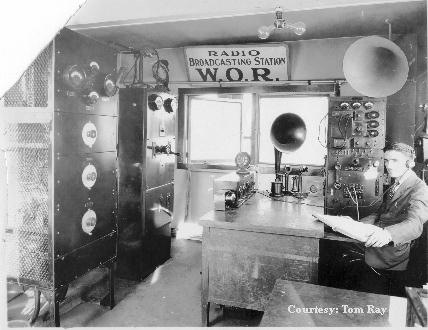| Licensed: February 20, 1922 (DOC License
#297, FRC License #177) First Broadcast: February 22, 1922 |
| Licensed: February 20, 1922 (DOC License
#297, FRC License #177) First Broadcast: February 22, 1922 |
|
|
|
|
The original WOR transmitter site in Newark, New
Jersey. |
deForest Transmitter Courtesy: C. Uzmann |
|
|
 |
|
The second WOR transmitter site in Newark, New
Jersey. |
WOR's second transmitter, a Western Electric 1A (or 1B) (The speaker is a WE 10-D, |
As we enter 2004, WOR is involved in rebuilding its transmitter site, a "short" move physically, but a challenging one, considering the number of stations in a small area in New Jersey. In addition to dealing with the FCC authorized pattern, work has to be done to avoid interacting with the neighboring stations. Chief Engineer Tom Ray is a good documentarian, so we will expect to see more pictures as the project continues.
More on WOR’s Tower History
Background on the story above from Tom Ray:
“The original 50 kW WOR site was in Carteret, N.J., built in the mid-1930s. It employed a three-tower in-line array (center tower was simply a wire suspended between the two end towers). The signal was a figure 8, hitting both N.Y and Philly.
“By the mid 1950s, with the growth of NYC, it became apparent that something needed to be done about the increasingly noisy WOR signal in NYC (sound familiar?). The Lyndhurst site is a former dump. The dump was closed, and the State of New Jersey was looking to redevelop this area.
“WOR purchased 45 acres of swamp/dump and built a new site, only 6.25 miles from midtown Manhattan. A three-tower array was used again, but this time in a dogleg arrangement, which bent the top of the figure 8 pattern over towards the city and Long Island, while maintaining the lobe towards Philadelphia. This array also had detuning skirts and networks, plus traps to keep out signals from other nearby AM stations.
“Because of the technology at the time, the effect on the efficiency of the antenna because of these traps and detunes would be unknown. The towers were therefore overly tall and the antenna built overly efficient as compensation for the percieved efficiency losses. Turns out the losses were minimal, and the site was grandfathered as overly efficient.
“Fast forward to 2006. The grandiose plans of the state for this area never materialized. In their quest to clean up the area, the state made a deal with a company called EnCap. Its business is to locate old dumps, enter into long-term leases from the local authorities, then clean and develop the properties. This isn’t just any dump. It is something like 4,000 acres and covers parts of three towns. The entire dump will be converted into three full-size golf courses, a train station, a couple of hotels, a ‘grand’ hotel, a couple of office buildings and a conference center. Plus over 2,000 housing units.